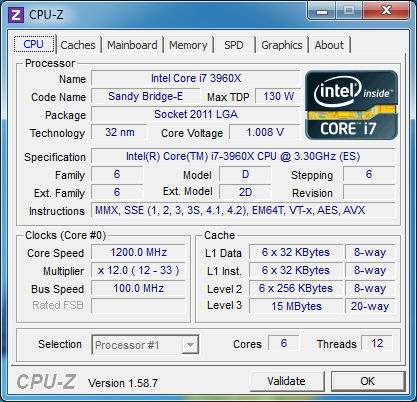Sandy Bridge-E: Core i7-3960X Is Fast, But Is It Any More Efficient?
Ironically, when it comes to performance, Intel’s Core i7-3960X is the real Bulldozer. Since its power consumption levels are lower than the Gulftown-based Core i7, it should also deliver amazing performance per watt as well. Is that really the case?
Sandy Bridge-E: Could The -E Stand For Efficiency?
Intel's Sandy Bridge-E design takes the company's 32 nm Sandy Bridge architecture to the next level. As you likely saw in Chris Angelini’s full review on Sandy Bridge-E And X79 Express, the new high-end processor family offers more of almost everything: more cores, more cache, more memory channels, and more PCI Express connectivity, resulting in better benchmark scores in almost every discipline.
While the new processor design, which is now available as the Core i7-3960X and Core i7-3930K (and Core i7-3820 some time next year) delivers more performance, we've already seen the first review machines based on X79 Express lowering power consumption versus the Gulftown/X58 combination thanks to the dual-chip platform layout. AMD might not want to learn in detail what this could mean in terms of performance per watt, since the six-core Core i7-990X was already faster than its flagship FX-8150.
The Numbers Game
The secret sauce of Sandy Bridge-E turns into a relatively simple recipe, which reads: do more of the same. This is made possible by the solid performance per core of Sandy Bridge, and the parallelism of a six-core implementation. In other words, it appears that Sandy Bridge scales very well, so it makes sense that Intel would introduce it as a six-core desktop offering and, later, an eight-core server-oriented Xeon processor.
In short, Sandy Bridge-E facilitates up to six cores (rather than the four you max out with on LGA 1155), includes four 64-bit memory channels (rather than LGA 1366's maximum of three), boasts official memory data rates as high as 1600 MT/s, and features 40 PCI Express 3.0-capable lanes. Moreover, the 2.27 billion-transistor processor occupies 434 mm2 of die space, too.
Getting Rid Of Dead Weight
But Sandy Bridge-E also sheds certain elements that might otherwise contribute to its overall power consumption. As on Sandy Bridge, power gating allows unused parts of the processor to be almost completely shut down, minimizing power consumption. Add that to the single-chip platform, which replaces its predecessor's two-chip layout, and you have the foundation for new lows in idle and peak power usage compared to any other six-core CPU in the lab.
Get Tom's Hardware's best news and in-depth reviews, straight to your inbox.
The promise, then, is one of new efficiency records, particularly in applications able to leverage Sandy Bridge-E's parallelism. Just recently, we looked at the performance per Watt of AMD’s FX processor in the article AMD FX: Energy Efficiency Compared To Eight Other CPUs. In today’s article, we’re performing the very same experiment.
So, if you’re in search of information on power efficiency, have a look at the aforementioned story. Or, if it's architectural details you're after, make sure you've already read our Sandy Bridge-E launch article for more the story about design and performance.
Sporting six cores, 32 nm lithography, 15 MB of shared L3 cache, and clock rates between 3.3 and 3.9 GHz, depending on workload, is the Core i7-3960X a good foundation on which to enable great power efficiency? It seems like it could be, as the idle power consumption of 87 W measured in our launch coverage represents a record low for a high-end desktop PC.
Current page: Sandy Bridge-E: Could The -E Stand For Efficiency?
Next Page Hardware: Core i7-3960X, Intel DX79SI, Radeon HD 6850
Patrick Schmid was the editor-in-chief for Tom's Hardware from 2005 to 2006. He wrote numerous articles on a wide range of hardware topics, including storage, CPUs, and system builds.
-
fstrthnu Aand yet more evidence that most people looking for a high-end processor will be perfectly fine with the i5-2500K or the 2600KReply -
sam_fisher fstrthnuAand yet more evidence that most people looking for a high-end processor will be perfectly fine with the i5-2500K or the 2600KReply
I guess it just depends on what you're doing. If you have a high end workstation and are using programs that are going to utilise all 12 threads, quad channel memory and 40 lanes of PCIe, and you need that processing power then it's probably not a bad investment. Whereas for most users the 2500K or the 2600K will do fine. -
benikens ReplyIronically, when it comes to performance, Intel’s Core i7-9360X is the real Bulldozer. Since its power consumption levels are lower than the Gulftown-based Core i7, it should also deliver amazing performance per watt as well. Is that really the case?
It's i7-3960x, not i7-9360x -
pwnorbpwnd Correct me if I'm wrong but isn't the 6850 a Barts card? Unless I am wrong but I own a 6850.Reply -
one-shot There is a small typo on Page 9Reply
"Total power used drops again relative to Cor ei7-3960X's predecessor, the Core i7-980X (Gulftown)." -
Shape ReplyIronically, when it comes to performance, Intel’s Core i7-9360X is the real Bulldozer.
ROFL!!! Very well said!
Nice! -
de5_Roy another informative, in-depth article about efficiency. great work guys!Reply
3960x might very well be the $1k cpu that's worth the (over)price unlike the older 980x.
sb-e shows that both single threaded and multi threaded performance as well as efficient power use can be ahcieved by a 32nm, 6 core, 130 tdp cpu (but you gotta pay a lot for that).
when you bring price into the equation, quad core sb i5 and i7(95w tdp) are the best way to go (i wonder how an i7 2700k fare if it was tested alongside these cpus). -
agnickolov And I was so hoping Visual C++ had made it into the regular benchmark set. Sadly, it's missing here...Reply -
giovanni86 Looking forward to seeing what type of Air/liquid cooled Overclocks can be achieved with these newly released processors.Reply

